Organizational Capacity and Change at Chiefley District Hospital
VerifiedAdded on 2022/08/29
|9
|2328
|45
Report
AI Summary
This report analyzes the organizational capacity and change management strategies of Chiefley District Hospital, a healthcare organization in Sydney, Australia. The hospital recently expanded its facilities to accommodate a growing and diversifying population, leading to an examination of its bureaucratic organizational structure. The report identifies strengths, such as the addition of specialized departments like pediatrics and geriatric care, alongside weaknesses including potential conflicts and administrative inefficiencies. It then recommends a transition to a matrix organizational structure to improve interdisciplinary collaboration, staff empowerment, and patient-centered care. The report highlights the benefits of this structure in addressing limitations of the current system, particularly in fostering effective community interactions and delivering high-quality healthcare services. The analysis considers the hospital's mission, vision, and goals in relation to its operational capacity and recommends strategies for optimizing its performance and patient outcomes.
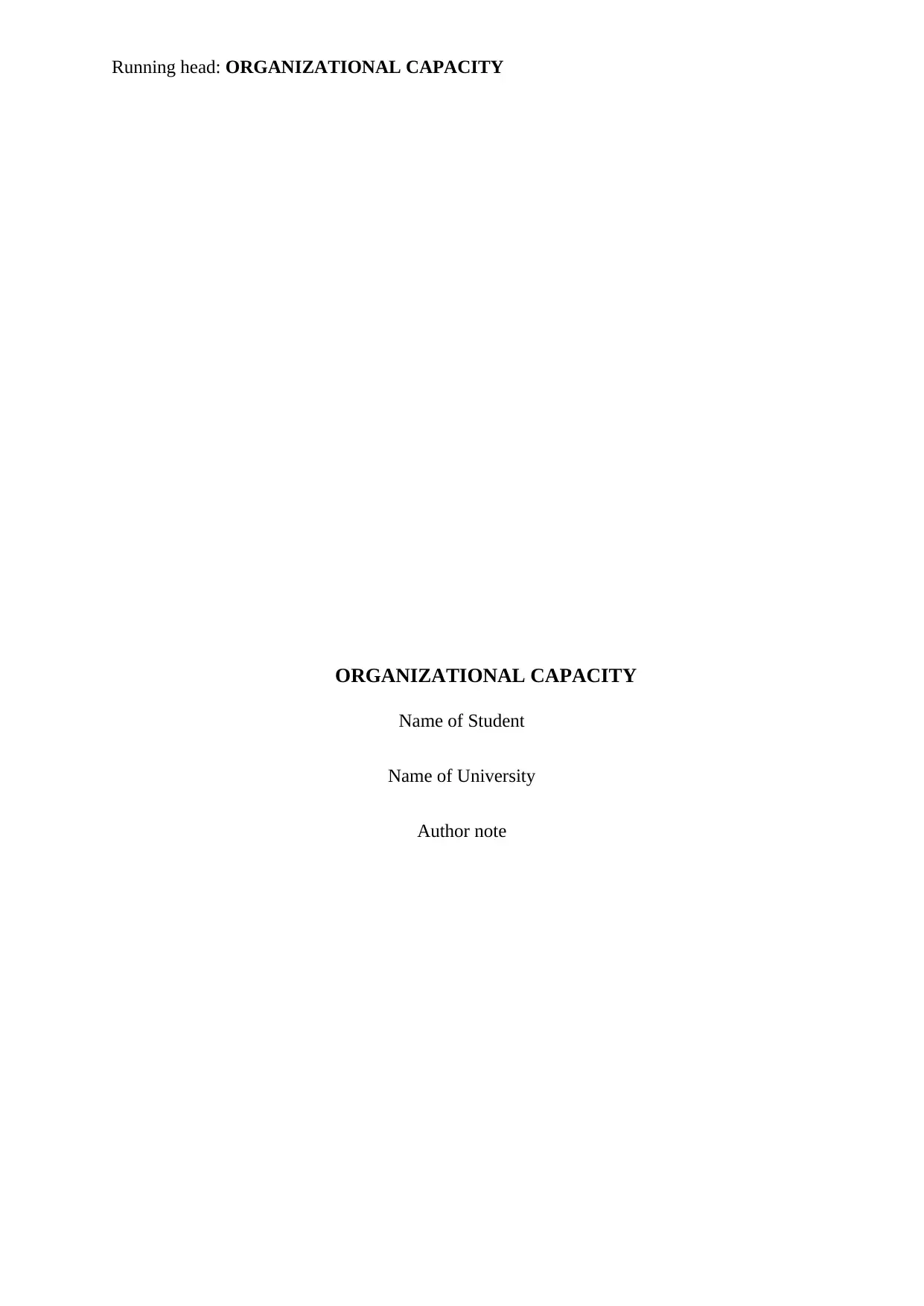
Running head: ORGANIZATIONAL CAPACITY
ORGANIZATIONAL CAPACITY
Name of Student
Name of University
Author note
ORGANIZATIONAL CAPACITY
Name of Student
Name of University
Author note
Paraphrase This Document
Need a fresh take? Get an instant paraphrase of this document with our AI Paraphraser
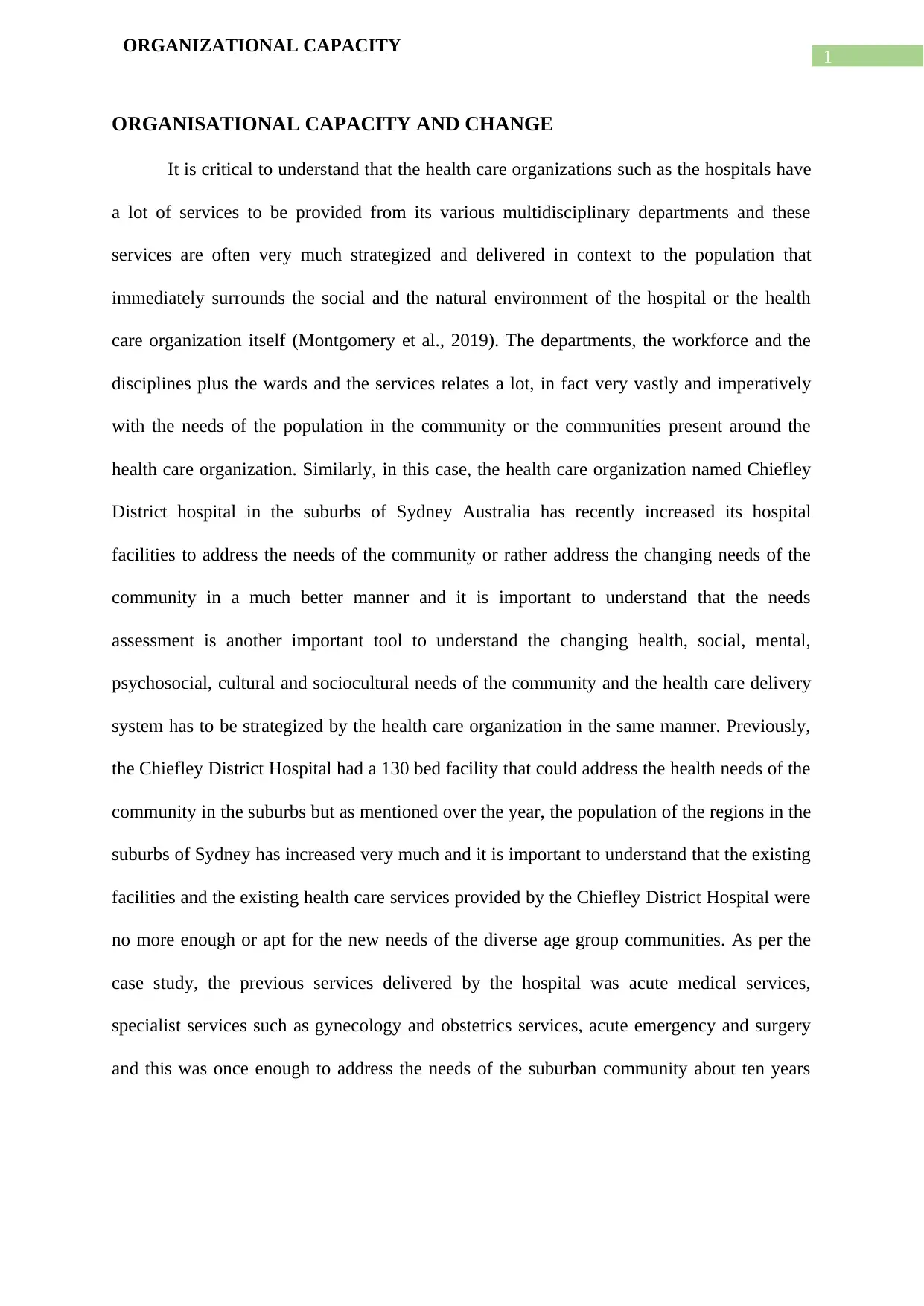
1
ORGANIZATIONAL CAPACITY
ORGANISATIONAL CAPACITY AND CHANGE
It is critical to understand that the health care organizations such as the hospitals have
a lot of services to be provided from its various multidisciplinary departments and these
services are often very much strategized and delivered in context to the population that
immediately surrounds the social and the natural environment of the hospital or the health
care organization itself (Montgomery et al., 2019). The departments, the workforce and the
disciplines plus the wards and the services relates a lot, in fact very vastly and imperatively
with the needs of the population in the community or the communities present around the
health care organization. Similarly, in this case, the health care organization named Chiefley
District hospital in the suburbs of Sydney Australia has recently increased its hospital
facilities to address the needs of the community or rather address the changing needs of the
community in a much better manner and it is important to understand that the needs
assessment is another important tool to understand the changing health, social, mental,
psychosocial, cultural and sociocultural needs of the community and the health care delivery
system has to be strategized by the health care organization in the same manner. Previously,
the Chiefley District Hospital had a 130 bed facility that could address the health needs of the
community in the suburbs but as mentioned over the year, the population of the regions in the
suburbs of Sydney has increased very much and it is important to understand that the existing
facilities and the existing health care services provided by the Chiefley District Hospital were
no more enough or apt for the new needs of the diverse age group communities. As per the
case study, the previous services delivered by the hospital was acute medical services,
specialist services such as gynecology and obstetrics services, acute emergency and surgery
and this was once enough to address the needs of the suburban community about ten years
ORGANIZATIONAL CAPACITY
ORGANISATIONAL CAPACITY AND CHANGE
It is critical to understand that the health care organizations such as the hospitals have
a lot of services to be provided from its various multidisciplinary departments and these
services are often very much strategized and delivered in context to the population that
immediately surrounds the social and the natural environment of the hospital or the health
care organization itself (Montgomery et al., 2019). The departments, the workforce and the
disciplines plus the wards and the services relates a lot, in fact very vastly and imperatively
with the needs of the population in the community or the communities present around the
health care organization. Similarly, in this case, the health care organization named Chiefley
District hospital in the suburbs of Sydney Australia has recently increased its hospital
facilities to address the needs of the community or rather address the changing needs of the
community in a much better manner and it is important to understand that the needs
assessment is another important tool to understand the changing health, social, mental,
psychosocial, cultural and sociocultural needs of the community and the health care delivery
system has to be strategized by the health care organization in the same manner. Previously,
the Chiefley District Hospital had a 130 bed facility that could address the health needs of the
community in the suburbs but as mentioned over the year, the population of the regions in the
suburbs of Sydney has increased very much and it is important to understand that the existing
facilities and the existing health care services provided by the Chiefley District Hospital were
no more enough or apt for the new needs of the diverse age group communities. As per the
case study, the previous services delivered by the hospital was acute medical services,
specialist services such as gynecology and obstetrics services, acute emergency and surgery
and this was once enough to address the needs of the suburban community about ten years
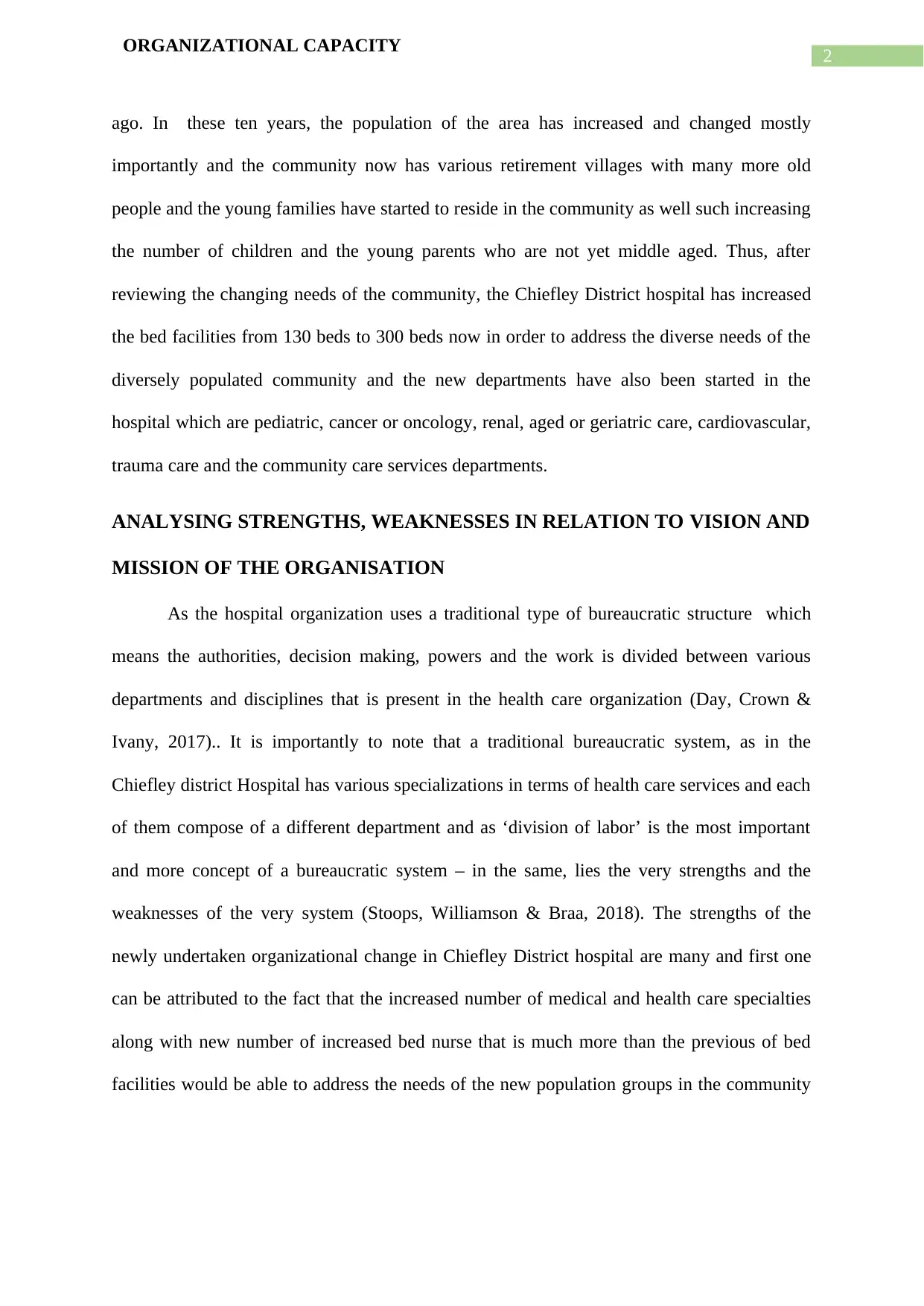
2
ORGANIZATIONAL CAPACITY
ago. In these ten years, the population of the area has increased and changed mostly
importantly and the community now has various retirement villages with many more old
people and the young families have started to reside in the community as well such increasing
the number of children and the young parents who are not yet middle aged. Thus, after
reviewing the changing needs of the community, the Chiefley District hospital has increased
the bed facilities from 130 beds to 300 beds now in order to address the diverse needs of the
diversely populated community and the new departments have also been started in the
hospital which are pediatric, cancer or oncology, renal, aged or geriatric care, cardiovascular,
trauma care and the community care services departments.
ANALYSING STRENGTHS, WEAKNESSES IN RELATION TO VISION AND
MISSION OF THE ORGANISATION
As the hospital organization uses a traditional type of bureaucratic structure which
means the authorities, decision making, powers and the work is divided between various
departments and disciplines that is present in the health care organization (Day, Crown &
Ivany, 2017).. It is importantly to note that a traditional bureaucratic system, as in the
Chiefley district Hospital has various specializations in terms of health care services and each
of them compose of a different department and as ‘division of labor’ is the most important
and more concept of a bureaucratic system – in the same, lies the very strengths and the
weaknesses of the very system (Stoops, Williamson & Braa, 2018). The strengths of the
newly undertaken organizational change in Chiefley District hospital are many and first one
can be attributed to the fact that the increased number of medical and health care specialties
along with new number of increased bed nurse that is much more than the previous of bed
facilities would be able to address the needs of the new population groups in the community
ORGANIZATIONAL CAPACITY
ago. In these ten years, the population of the area has increased and changed mostly
importantly and the community now has various retirement villages with many more old
people and the young families have started to reside in the community as well such increasing
the number of children and the young parents who are not yet middle aged. Thus, after
reviewing the changing needs of the community, the Chiefley District hospital has increased
the bed facilities from 130 beds to 300 beds now in order to address the diverse needs of the
diversely populated community and the new departments have also been started in the
hospital which are pediatric, cancer or oncology, renal, aged or geriatric care, cardiovascular,
trauma care and the community care services departments.
ANALYSING STRENGTHS, WEAKNESSES IN RELATION TO VISION AND
MISSION OF THE ORGANISATION
As the hospital organization uses a traditional type of bureaucratic structure which
means the authorities, decision making, powers and the work is divided between various
departments and disciplines that is present in the health care organization (Day, Crown &
Ivany, 2017).. It is importantly to note that a traditional bureaucratic system, as in the
Chiefley district Hospital has various specializations in terms of health care services and each
of them compose of a different department and as ‘division of labor’ is the most important
and more concept of a bureaucratic system – in the same, lies the very strengths and the
weaknesses of the very system (Stoops, Williamson & Braa, 2018). The strengths of the
newly undertaken organizational change in Chiefley District hospital are many and first one
can be attributed to the fact that the increased number of medical and health care specialties
along with new number of increased bed nurse that is much more than the previous of bed
facilities would be able to address the needs of the new population groups in the community
⊘ This is a preview!⊘
Do you want full access?
Subscribe today to unlock all pages.

Trusted by 1+ million students worldwide
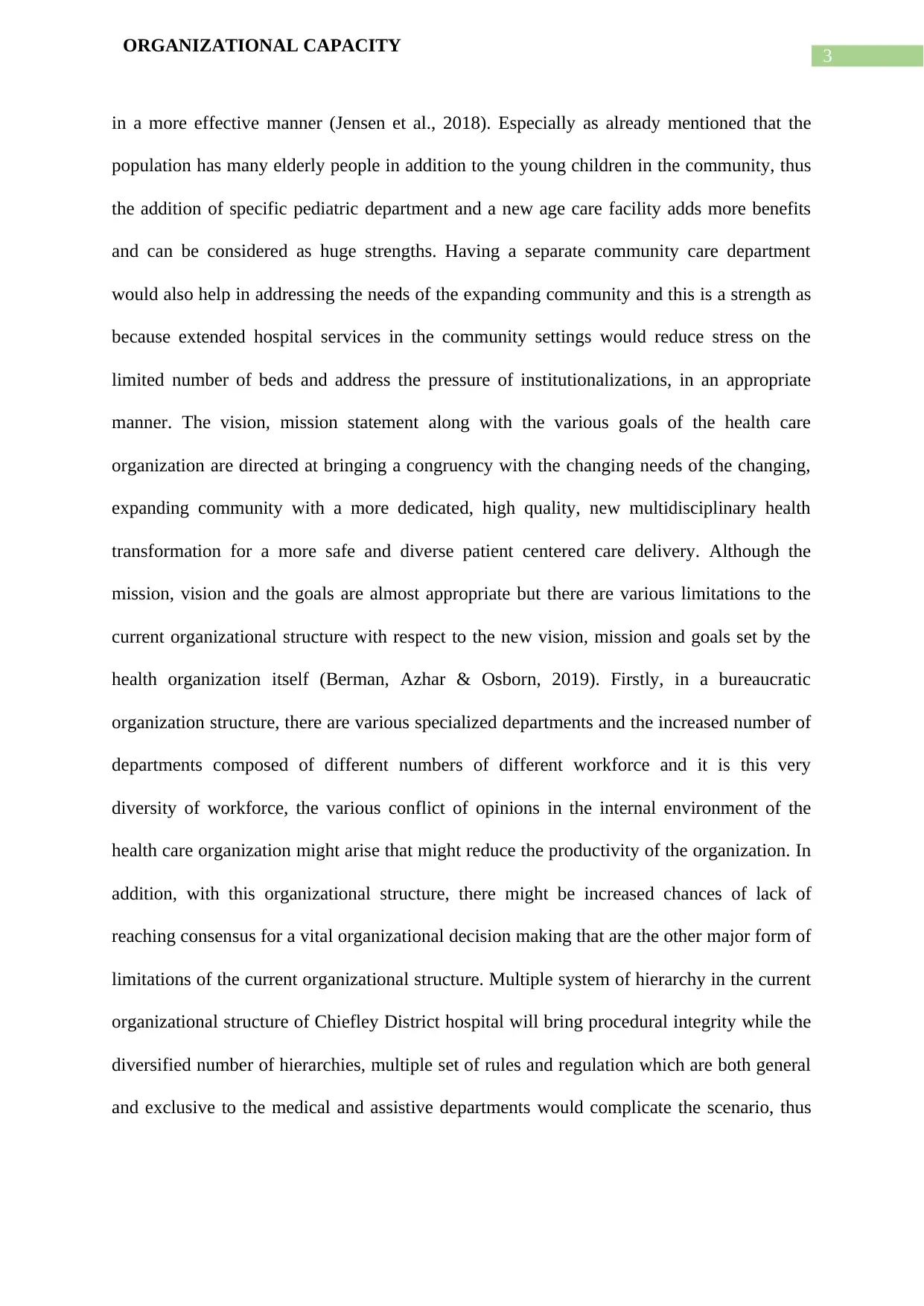
3
ORGANIZATIONAL CAPACITY
in a more effective manner (Jensen et al., 2018). Especially as already mentioned that the
population has many elderly people in addition to the young children in the community, thus
the addition of specific pediatric department and a new age care facility adds more benefits
and can be considered as huge strengths. Having a separate community care department
would also help in addressing the needs of the expanding community and this is a strength as
because extended hospital services in the community settings would reduce stress on the
limited number of beds and address the pressure of institutionalizations, in an appropriate
manner. The vision, mission statement along with the various goals of the health care
organization are directed at bringing a congruency with the changing needs of the changing,
expanding community with a more dedicated, high quality, new multidisciplinary health
transformation for a more safe and diverse patient centered care delivery. Although the
mission, vision and the goals are almost appropriate but there are various limitations to the
current organizational structure with respect to the new vision, mission and goals set by the
health organization itself (Berman, Azhar & Osborn, 2019). Firstly, in a bureaucratic
organization structure, there are various specialized departments and the increased number of
departments composed of different numbers of different workforce and it is this very
diversity of workforce, the various conflict of opinions in the internal environment of the
health care organization might arise that might reduce the productivity of the organization. In
addition, with this organizational structure, there might be increased chances of lack of
reaching consensus for a vital organizational decision making that are the other major form of
limitations of the current organizational structure. Multiple system of hierarchy in the current
organizational structure of Chiefley District hospital will bring procedural integrity while the
diversified number of hierarchies, multiple set of rules and regulation which are both general
and exclusive to the medical and assistive departments would complicate the scenario, thus
ORGANIZATIONAL CAPACITY
in a more effective manner (Jensen et al., 2018). Especially as already mentioned that the
population has many elderly people in addition to the young children in the community, thus
the addition of specific pediatric department and a new age care facility adds more benefits
and can be considered as huge strengths. Having a separate community care department
would also help in addressing the needs of the expanding community and this is a strength as
because extended hospital services in the community settings would reduce stress on the
limited number of beds and address the pressure of institutionalizations, in an appropriate
manner. The vision, mission statement along with the various goals of the health care
organization are directed at bringing a congruency with the changing needs of the changing,
expanding community with a more dedicated, high quality, new multidisciplinary health
transformation for a more safe and diverse patient centered care delivery. Although the
mission, vision and the goals are almost appropriate but there are various limitations to the
current organizational structure with respect to the new vision, mission and goals set by the
health organization itself (Berman, Azhar & Osborn, 2019). Firstly, in a bureaucratic
organization structure, there are various specialized departments and the increased number of
departments composed of different numbers of different workforce and it is this very
diversity of workforce, the various conflict of opinions in the internal environment of the
health care organization might arise that might reduce the productivity of the organization. In
addition, with this organizational structure, there might be increased chances of lack of
reaching consensus for a vital organizational decision making that are the other major form of
limitations of the current organizational structure. Multiple system of hierarchy in the current
organizational structure of Chiefley District hospital will bring procedural integrity while the
diversified number of hierarchies, multiple set of rules and regulation which are both general
and exclusive to the medical and assistive departments would complicate the scenario, thus
Paraphrase This Document
Need a fresh take? Get an instant paraphrase of this document with our AI Paraphraser

4
ORGANIZATIONAL CAPACITY
adding to the more chances of workplace disruption, missed health care services, lack of
compliance with the evidence based practice protocols and a resultant shift of focus from the
patient centered, multidisciplinary care as mentioned in the mission, vision, goals to a more
disruptive organizational culture with low productivity – can occur, with current
organizational structure (Gaff et al., 2017). Another huge limitation to this structure is that it
can have a high cost of administration for the administrative officials have to look into
various affairs and various processes and increase of expense in this area can affect the
instruments and biomedical device cost effectiveness thus affecting the patient care in the
community and in the institution to a great extent. Moreover, in the current bureaucratic
organizational structure of the Chiefley District hospital, various issues pertaining to the red
tape situations such as stress, anxiety, burnout of the health care staffs especially for they
have to adhere to the patient care policies and all the evidence based practice care protocols
in all the procedures would finally led to low and disruptive organizational productivity
(Pomare et al., 2019). Rigidity of the system, impersonation and person al conflicts, increased
pressure of documentation and compartmentalization of ideas and thinking can also decrease
patient care quality lead to patient and community dissatisfaction (Blake & Lloyd, 2020).
RECOMMENDATION OF A NEW ORGANIZATIONAL STRUCTURE
As to address the above mentioned limitations of the current organizational structure
in relation to the mission, vision and goals – the new organizational structure is
recommended that is a Matrix Organization Structure. This is a more effective functional
approach to meet the needs of the health care staffs and the others staffs inside the health care
organization. This organizational structure is more suited for the meeting of vision, mission
and goals of the health organization as because in this structure the middle management is
ORGANIZATIONAL CAPACITY
adding to the more chances of workplace disruption, missed health care services, lack of
compliance with the evidence based practice protocols and a resultant shift of focus from the
patient centered, multidisciplinary care as mentioned in the mission, vision, goals to a more
disruptive organizational culture with low productivity – can occur, with current
organizational structure (Gaff et al., 2017). Another huge limitation to this structure is that it
can have a high cost of administration for the administrative officials have to look into
various affairs and various processes and increase of expense in this area can affect the
instruments and biomedical device cost effectiveness thus affecting the patient care in the
community and in the institution to a great extent. Moreover, in the current bureaucratic
organizational structure of the Chiefley District hospital, various issues pertaining to the red
tape situations such as stress, anxiety, burnout of the health care staffs especially for they
have to adhere to the patient care policies and all the evidence based practice care protocols
in all the procedures would finally led to low and disruptive organizational productivity
(Pomare et al., 2019). Rigidity of the system, impersonation and person al conflicts, increased
pressure of documentation and compartmentalization of ideas and thinking can also decrease
patient care quality lead to patient and community dissatisfaction (Blake & Lloyd, 2020).
RECOMMENDATION OF A NEW ORGANIZATIONAL STRUCTURE
As to address the above mentioned limitations of the current organizational structure
in relation to the mission, vision and goals – the new organizational structure is
recommended that is a Matrix Organization Structure. This is a more effective functional
approach to meet the needs of the health care staffs and the others staffs inside the health care
organization. This organizational structure is more suited for the meeting of vision, mission
and goals of the health organization as because in this structure the middle management is
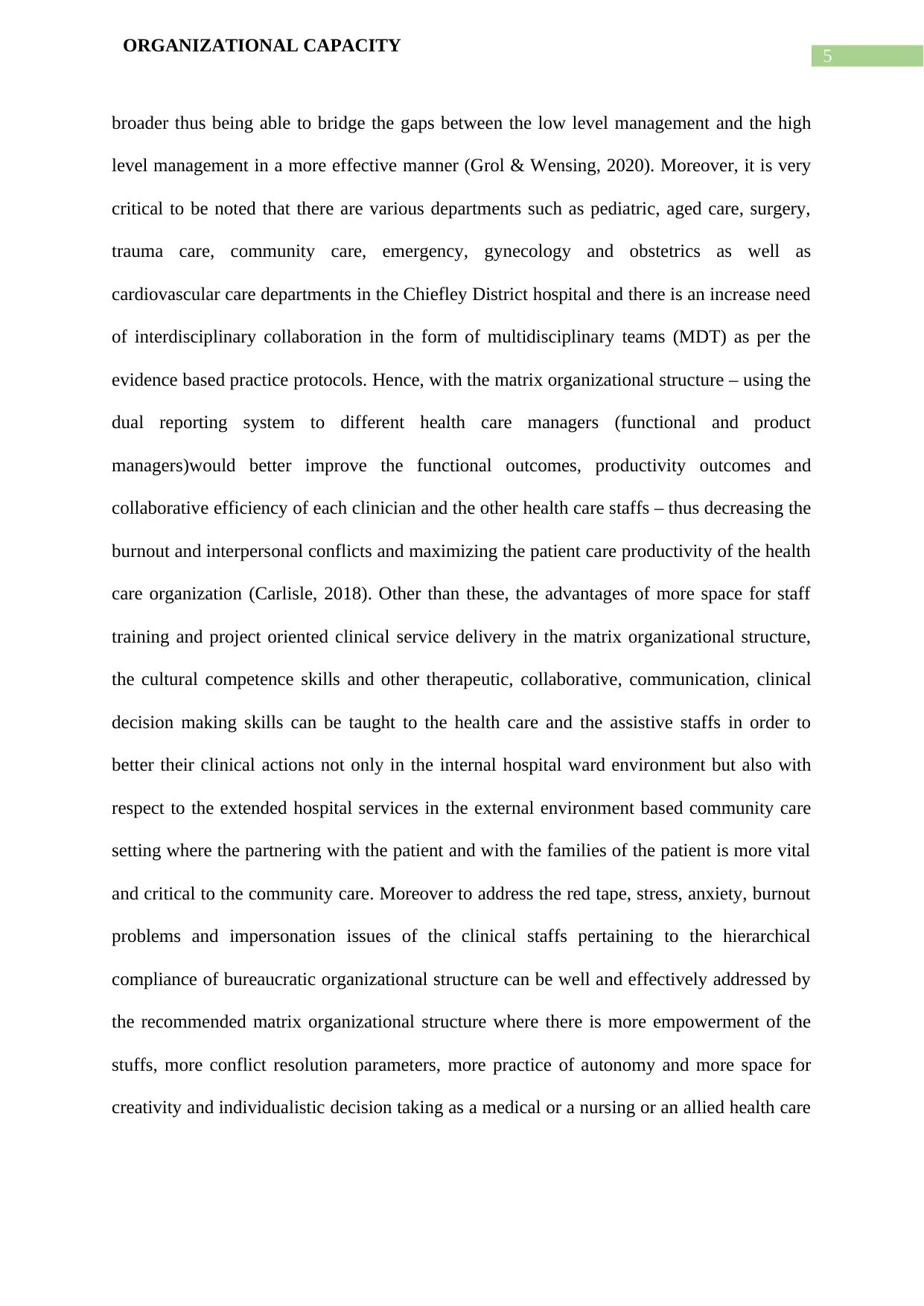
5
ORGANIZATIONAL CAPACITY
broader thus being able to bridge the gaps between the low level management and the high
level management in a more effective manner (Grol & Wensing, 2020). Moreover, it is very
critical to be noted that there are various departments such as pediatric, aged care, surgery,
trauma care, community care, emergency, gynecology and obstetrics as well as
cardiovascular care departments in the Chiefley District hospital and there is an increase need
of interdisciplinary collaboration in the form of multidisciplinary teams (MDT) as per the
evidence based practice protocols. Hence, with the matrix organizational structure – using the
dual reporting system to different health care managers (functional and product
managers)would better improve the functional outcomes, productivity outcomes and
collaborative efficiency of each clinician and the other health care staffs – thus decreasing the
burnout and interpersonal conflicts and maximizing the patient care productivity of the health
care organization (Carlisle, 2018). Other than these, the advantages of more space for staff
training and project oriented clinical service delivery in the matrix organizational structure,
the cultural competence skills and other therapeutic, collaborative, communication, clinical
decision making skills can be taught to the health care and the assistive staffs in order to
better their clinical actions not only in the internal hospital ward environment but also with
respect to the extended hospital services in the external environment based community care
setting where the partnering with the patient and with the families of the patient is more vital
and critical to the community care. Moreover to address the red tape, stress, anxiety, burnout
problems and impersonation issues of the clinical staffs pertaining to the hierarchical
compliance of bureaucratic organizational structure can be well and effectively addressed by
the recommended matrix organizational structure where there is more empowerment of the
stuffs, more conflict resolution parameters, more practice of autonomy and more space for
creativity and individualistic decision taking as a medical or a nursing or an allied health care
ORGANIZATIONAL CAPACITY
broader thus being able to bridge the gaps between the low level management and the high
level management in a more effective manner (Grol & Wensing, 2020). Moreover, it is very
critical to be noted that there are various departments such as pediatric, aged care, surgery,
trauma care, community care, emergency, gynecology and obstetrics as well as
cardiovascular care departments in the Chiefley District hospital and there is an increase need
of interdisciplinary collaboration in the form of multidisciplinary teams (MDT) as per the
evidence based practice protocols. Hence, with the matrix organizational structure – using the
dual reporting system to different health care managers (functional and product
managers)would better improve the functional outcomes, productivity outcomes and
collaborative efficiency of each clinician and the other health care staffs – thus decreasing the
burnout and interpersonal conflicts and maximizing the patient care productivity of the health
care organization (Carlisle, 2018). Other than these, the advantages of more space for staff
training and project oriented clinical service delivery in the matrix organizational structure,
the cultural competence skills and other therapeutic, collaborative, communication, clinical
decision making skills can be taught to the health care and the assistive staffs in order to
better their clinical actions not only in the internal hospital ward environment but also with
respect to the extended hospital services in the external environment based community care
setting where the partnering with the patient and with the families of the patient is more vital
and critical to the community care. Moreover to address the red tape, stress, anxiety, burnout
problems and impersonation issues of the clinical staffs pertaining to the hierarchical
compliance of bureaucratic organizational structure can be well and effectively addressed by
the recommended matrix organizational structure where there is more empowerment of the
stuffs, more conflict resolution parameters, more practice of autonomy and more space for
creativity and individualistic decision taking as a medical or a nursing or an allied health care
⊘ This is a preview!⊘
Do you want full access?
Subscribe today to unlock all pages.

Trusted by 1+ million students worldwide
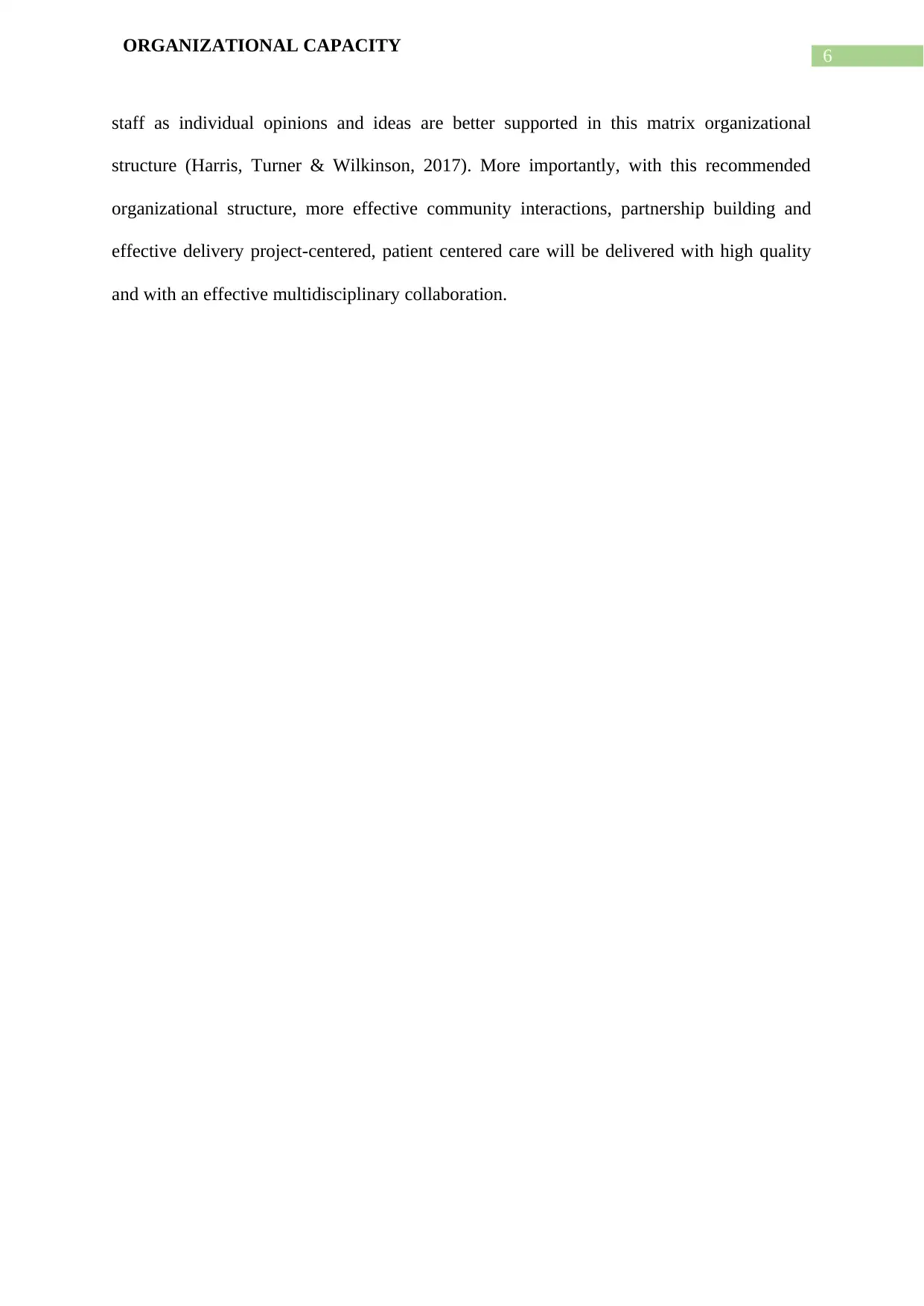
6
ORGANIZATIONAL CAPACITY
staff as individual opinions and ideas are better supported in this matrix organizational
structure (Harris, Turner & Wilkinson, 2017). More importantly, with this recommended
organizational structure, more effective community interactions, partnership building and
effective delivery project-centered, patient centered care will be delivered with high quality
and with an effective multidisciplinary collaboration.
ORGANIZATIONAL CAPACITY
staff as individual opinions and ideas are better supported in this matrix organizational
structure (Harris, Turner & Wilkinson, 2017). More importantly, with this recommended
organizational structure, more effective community interactions, partnership building and
effective delivery project-centered, patient centered care will be delivered with high quality
and with an effective multidisciplinary collaboration.
Paraphrase This Document
Need a fresh take? Get an instant paraphrase of this document with our AI Paraphraser
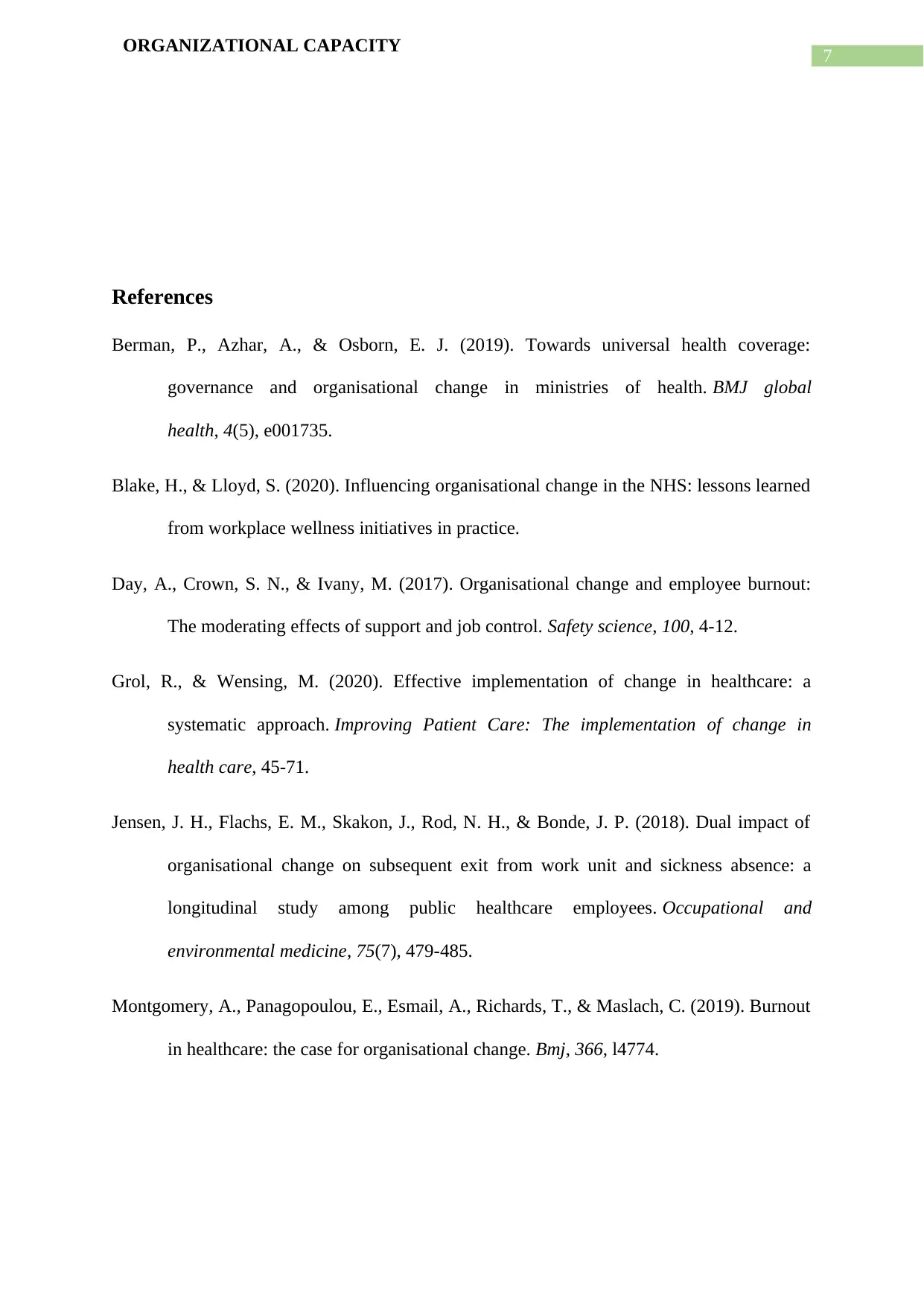
7
ORGANIZATIONAL CAPACITY
References
Berman, P., Azhar, A., & Osborn, E. J. (2019). Towards universal health coverage:
governance and organisational change in ministries of health. BMJ global
health, 4(5), e001735.
Blake, H., & Lloyd, S. (2020). Influencing organisational change in the NHS: lessons learned
from workplace wellness initiatives in practice.
Day, A., Crown, S. N., & Ivany, M. (2017). Organisational change and employee burnout:
The moderating effects of support and job control. Safety science, 100, 4-12.
Grol, R., & Wensing, M. (2020). Effective implementation of change in healthcare: a
systematic approach. Improving Patient Care: The implementation of change in
health care, 45-71.
Jensen, J. H., Flachs, E. M., Skakon, J., Rod, N. H., & Bonde, J. P. (2018). Dual impact of
organisational change on subsequent exit from work unit and sickness absence: a
longitudinal study among public healthcare employees. Occupational and
environmental medicine, 75(7), 479-485.
Montgomery, A., Panagopoulou, E., Esmail, A., Richards, T., & Maslach, C. (2019). Burnout
in healthcare: the case for organisational change. Bmj, 366, l4774.
ORGANIZATIONAL CAPACITY
References
Berman, P., Azhar, A., & Osborn, E. J. (2019). Towards universal health coverage:
governance and organisational change in ministries of health. BMJ global
health, 4(5), e001735.
Blake, H., & Lloyd, S. (2020). Influencing organisational change in the NHS: lessons learned
from workplace wellness initiatives in practice.
Day, A., Crown, S. N., & Ivany, M. (2017). Organisational change and employee burnout:
The moderating effects of support and job control. Safety science, 100, 4-12.
Grol, R., & Wensing, M. (2020). Effective implementation of change in healthcare: a
systematic approach. Improving Patient Care: The implementation of change in
health care, 45-71.
Jensen, J. H., Flachs, E. M., Skakon, J., Rod, N. H., & Bonde, J. P. (2018). Dual impact of
organisational change on subsequent exit from work unit and sickness absence: a
longitudinal study among public healthcare employees. Occupational and
environmental medicine, 75(7), 479-485.
Montgomery, A., Panagopoulou, E., Esmail, A., Richards, T., & Maslach, C. (2019). Burnout
in healthcare: the case for organisational change. Bmj, 366, l4774.

8
ORGANIZATIONAL CAPACITY
Pomare, C., Churruca, K., Long, J. C., Ellis, L. A., & Braithwaite, J. (2019). Organisational
change in hospitals: a qualitative case-study of staff perspectives. BMC health
services research, 19(1), 840.
Stoops, N., Williamson, L., & Braa, J. (2018). Using health information for local action:
facilitating organisational change in South Africa. The Digital Challenge: Information
Technology in the Development Context: Information Technology in the Development
Context.
Gaff, C. L., Winship, I. M., Forrest, S. M., Hansen, D. P., Clark, J., Waring, P. M., ... &
Sinclair, A. H. (2017). Preparing for genomic medicine: a real world demonstration of
health system change. NPJ genomic medicine, 2(1), 1-9.
Harris, C., Turner, T., & Wilkinson, F. (2017). SEAchange: Guide to a pragmatic evidence-
based approach to Sustainable, Effective and Appropriate change in health services.
2015.
Carlisle, J. L. (2018). Organisational Predictors of In-Role Job Performance of Nurses in the
Australian Healthcare sector: A Psychometric Analysis of Training Effectiveness and
the Mediating and Moderating roles of Work Environment and Organisational
Change (Doctoral dissertation, Charles Sturt University Australia).
ORGANIZATIONAL CAPACITY
Pomare, C., Churruca, K., Long, J. C., Ellis, L. A., & Braithwaite, J. (2019). Organisational
change in hospitals: a qualitative case-study of staff perspectives. BMC health
services research, 19(1), 840.
Stoops, N., Williamson, L., & Braa, J. (2018). Using health information for local action:
facilitating organisational change in South Africa. The Digital Challenge: Information
Technology in the Development Context: Information Technology in the Development
Context.
Gaff, C. L., Winship, I. M., Forrest, S. M., Hansen, D. P., Clark, J., Waring, P. M., ... &
Sinclair, A. H. (2017). Preparing for genomic medicine: a real world demonstration of
health system change. NPJ genomic medicine, 2(1), 1-9.
Harris, C., Turner, T., & Wilkinson, F. (2017). SEAchange: Guide to a pragmatic evidence-
based approach to Sustainable, Effective and Appropriate change in health services.
2015.
Carlisle, J. L. (2018). Organisational Predictors of In-Role Job Performance of Nurses in the
Australian Healthcare sector: A Psychometric Analysis of Training Effectiveness and
the Mediating and Moderating roles of Work Environment and Organisational
Change (Doctoral dissertation, Charles Sturt University Australia).
⊘ This is a preview!⊘
Do you want full access?
Subscribe today to unlock all pages.

Trusted by 1+ million students worldwide
1 out of 9
Related Documents
Your All-in-One AI-Powered Toolkit for Academic Success.
+13062052269
info@desklib.com
Available 24*7 on WhatsApp / Email
![[object Object]](/_next/static/media/star-bottom.7253800d.svg)
Unlock your academic potential
Copyright © 2020–2025 A2Z Services. All Rights Reserved. Developed and managed by ZUCOL.





